It’s a fish that lived alongside dinosaurs, and held its own: A slimy and voracious creature with a mouth full of sharp teeth.
And you don’t have to wait for Jurassic Park to see one: the bowfin is still among us. It has proven tougher than T. rex. But is it tough enough to survive humanity?
I recall well my first encounter: pulling that bizarre fish with the long dorsal fin into a boat, as part of fish surveys I was conducting on Michigan’s Muskegon River. I’d read about these fish before in class, but had never seen one alive.
I just had to get a better look at this fish. And that was the beginning of my fascination with this incredible, but often underappreciated, animal.

Mudfish, dogfish, grinnel, swamp-muskie: the names alone suggest why bowfin (Amia calva) are generally not the most highly-revered among fishes.
With their prehistoric appearance and tenacious attitude, one may say they deserve their poor reputation. But the bowfin is in reality a fascinating, resilient, and even beneficial species.
What we see today in the backwaters and wetlands of eastern North America is a modern representative of a very ancient line of “primitive” fishes or “living fossils,” organisms that appear to have changed little over time. The sole remainder of a once diverse group; bowfins (order Amiiformes), have been around for over 150 million years.
Bowfin look the part of a living fossil, too. In fact, they’re full of fascinating features that have captivated my fishy imagination.
Distinguishing the bowfin from your typical “gamefish,” Amia calva possesses an elongate dorsal fin, which is capable of near-hypnotic undulations (I recommend checking them out in a public aquarium and this video), allowing the fish to swim backward just as easily as forward.
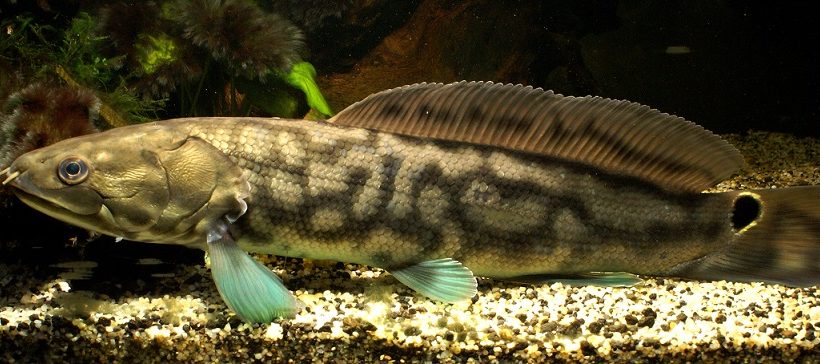
Photo: Solomon David
This comes in handy when navigating their preferred, highly-vegetated habitats. Adding to a glamorous appearance only a mother (and a few of us bowfin enthusiasts) could love, Bowfin have tubular nostrils on a bony, rounded head; their sense of smell is much better than their eyesight.
They are also quite strong and slimy, so getting a grip on them, whether predator, angler, or fisheries biologist, can be quite challenging!
Other notable features include a bony plate on the lower jaw, known as the “gular plate”, and a yellow-ringed eye-spot or ocellus, found near the tail in juveniles and males (the ocellus is often absent or reduced to a black blotch in mature females).
The function of this eye-spot may be two-fold. First, the camouflage of a false eye near the tail can misdirect an attacking predator. It’s easier to regrow you tailfin than your head!
This feature comes in handy particularly for young-of-year bowfin.
And it may help young bowfin in another way. The eye-spot on the male may serve as a homing pattern for young bowfin to follow; after all, it is the male bowfin that aggressively guards the nest once eggs are laid, and then shepherds around the young fish in a massive “bowfin ball” until they reach 2-3”in length and disperse.
This behavior is unique in that it is the only occurrence of parental care in surviving “primitive” ray-finned fishes (e.g. sturgeons, paddlefish, polypterids, and gars).
Bowfin also possess adaptations which have probably helped them persist from dinosaur to modern times. Sure, there’s the tenacious attitude and seemingly insatiable opportunistic appetite. But they can also breathe air using an organ called a modified gas bladder, which can be used like a SCUBA tank.
Whereas most fishes must acquire oxygen from water using their gills, Bowfin can gulp air from the surface, temporarily storing it in their blood-vessel-rich gas bladder, which works like a lung.
When oxygen in the tank is used up, they return to the surface, releasing the O2-depleted air out the gill chambers and gulping new air through the mouth. This adaptation allows Bowfin to persist in warmer, low-oxygen waters, where more conventionally-breathing fishes (like perch, bass, or walleye) may be unable to survive.
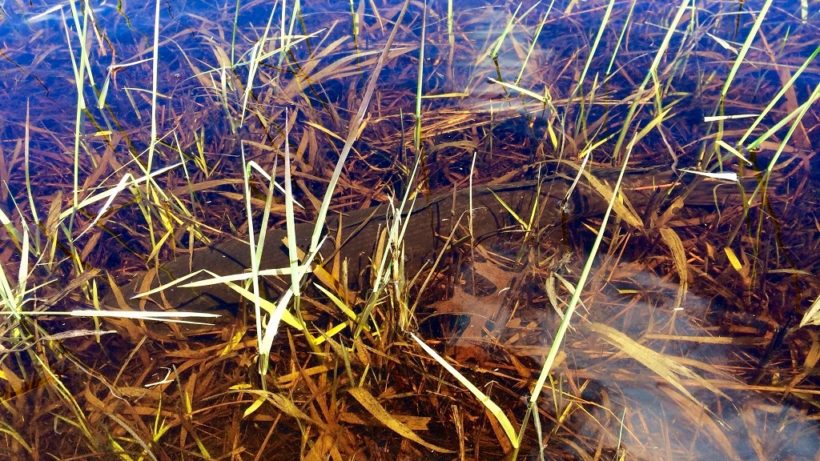
The bowfin lineage has persisted for over 150 million years, surviving extinction events that killed the dinosaurs and many other species, but can they survive this modern age of humans?
Bowfin have a bad reputation for supposedly negatively impacting sportfish populations by eating young game fish and game fish food; in some cases they are blamed for “taking over” entire lakes and backwater habitats.
The science, however, has shown otherwise; indicating bowfin, like other well-known predators (such as pike and muskellunge) will eat whatever prey is most abundant, including crustaceans (crayfish, freshwater shrimp), forage fish (shad, minnows), or game fish.
In doing so, bowfin can help prevent the overpopulation of forage fishes and stunting in game fishes such as sunfish and bass, therefore maintaining a balanced ecosystem. I highly recommend reading Scarnecchia’s essay, “Reappraisal of Gars & Bowfin in Fishery Management,” which delves much deeper into this oft-debated topic.
It is unfortunately often a familiar theme for fish conservationists: a native fish blamed for crimes it didn’t commit.
It is unfortunately often a familiar theme for fish conservationists: a native fish blamed for crimes it didn’t commit.
Aside from the eradication activities mentioned by Scarnecchia 1992 (some as extreme as dynamite blasting!), other current threats are habitat loss and wasteful harvest. Why are these two issues important to anglers and nature enthusiasts, and what are scientists doing about it?
Habitat loss is one of the primary threats to biodiversity worldwide, whether in rainforests, coral reefs, or the backwaters of eastern North America. Those highly vegetated habitats preferred by Bowfin are also nursery areas for young game fish species.
When we use herbicides to clear vegetation for boats, or fully drain and develop wetland sites, we are often negatively impacting native biodiversity, ecosystem function, and the balance of food webs (including “popular” game fish species). These activities also tend to pave the way for invasive species, since a less resilient ecosystem is often more vulnerable to invasion.
However, hope is not lost for bowfin and residents of these vegetated habitats!
Collaborative research by The Nature Conservancy, Shedd Aquarium, and University of Wisconsin (Green Bay & Madison) is investigating the efficacy of restoration wetlands, providing spawning habitat for migratory fishes such as northern pike.
So far we’ve found that if we create new habitat, the fishes will come; this includes our native underdog, the bowfin.
Over the past three years we have not only recorded the first observations of bowfin in these restoration habitats, but also successful natural reproduction and site fidelity (returning to the same site annually).
These findings are important as they indicate several fish species quickly take advantage of newly available habitat, scoring some points for restoration efforts!
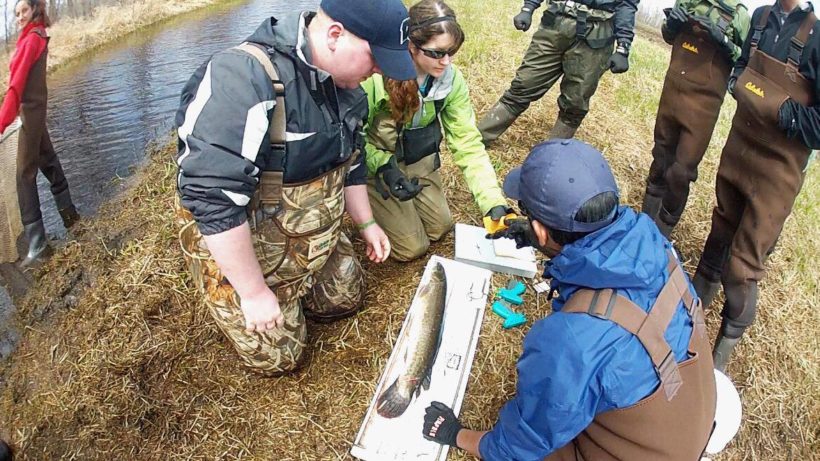
Wasteful harvest (and sometimes flat-out eradication) is also a threat to bowfin. Because they aren’t considered traditional “game fish” (a term that’s highly relative, and should indeed be applied to Bowfin), alternative methods of harvest are often used (and legal) for the species, such as bowfishing.
Although many bowfishers eat what they catch (I’ve had fried Bowfin and it’s delicious), some do not, and the fish are often discarded or turned into fertilizer.
Wouldn’t native apex predators do more good maintaining balance in ecosystems and food webs than pushing up agriculture?
It’s hard to say how much bowfishing and other harvest methods impact Bowfin, although previous research indicates they typically make up a small percentage of resident fish populations.
At the very least, they aren’t deserving of wasteful eradication by some anglers who might consider them “trash fish”. A bass fisherman would never dream of catching a muskie and discarding it because it eats bass, so why consider bowfin in such a light?
Once again, fisheries scientists and ecologists are working toward a balance for management of this natural resource. The Sport Fish Ecology Lab at the Illinois Natural History Survey has initiated the Ancient Sport Fish Project to assess bowfin (and gar) populations throughout the state to better understand population status and trends, as well as informing the potential for management strategies that create a sustainable ancient sport fishery.
The goal of this project is to gather the missing data managers will use to develop options for sustainable harvest while maintaining balanced food webs.
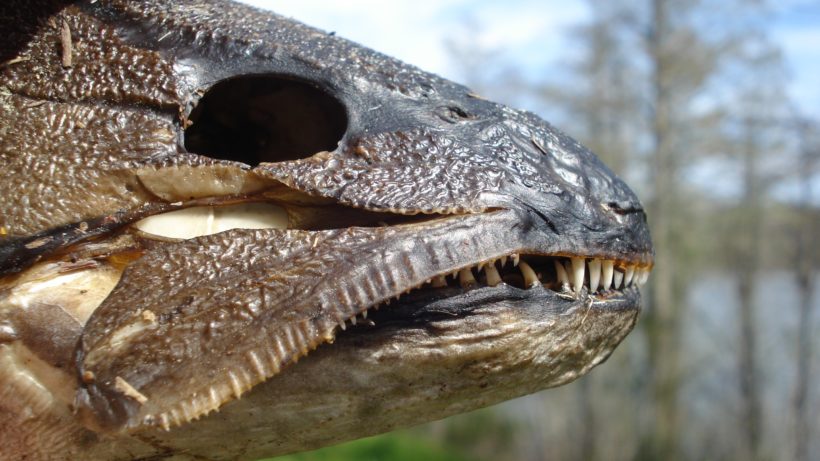
Ancient survivors representative of native biodiversity much older than ourselves, Bowfin have indeed outlasted T. rex and friends. They possess adaptations that give them home-pond advantage over the typical perch or bass. Their persistence, however, requires us to be proper stewards of our environment, conserving creatures whether they are charismatic megafauna or backwater underdog.
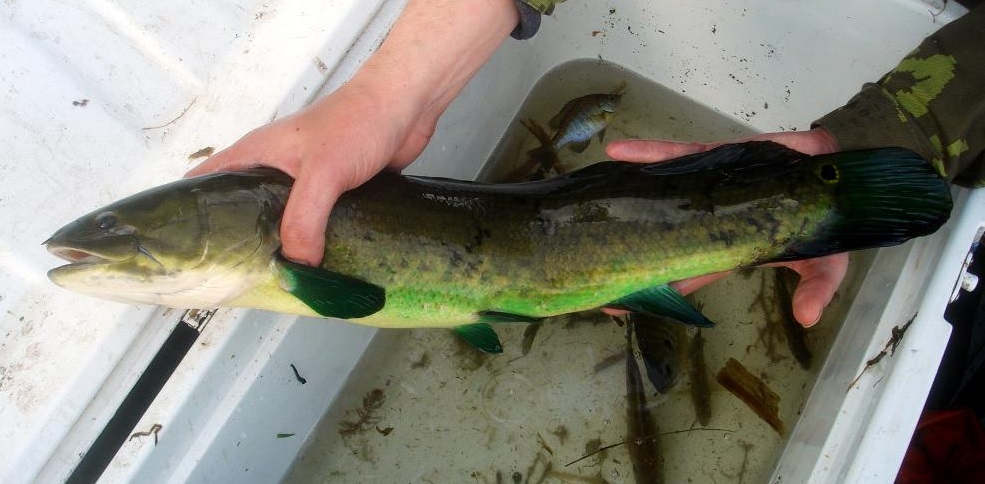



Bowfin are awesome to cacth and eat I love fishing for them.
Caught 2 today about 2 feet long down in Carrollton ga.
Caught a male about a foot long with a bright green belly and fins today (5-28-2018) just past the outlet of the Bolivar Dam in northeastern Ohio. (Part of the Muskingum Watershed District.) Was intrigued, but not knowing what it was, released it back into the water as we usually do with most fish. What a treat to research what it is and find this article! Thank you for educating us. We were wondering how big do they usually get? We also caught small-mouth bass, carp, catfish and something with vertical strips that was extremely heavy and about 10 inches long that we couldn’t identify. All, of course, were catch and release.
i cot one before
I am a Master Naturalist with no interest in fishing. Yesterday while exploring the wetlands along a slough near the James River in VA, I found a very interesting large fish skull with teeth. Of course I collected it and sent a photo to a fishing guide who identified it as a bowfin. After reading your article about its uniqueness & the fact that the male cares for the young, my freakish find is now a valued treasure. Thanks for the info.
I fished these prehistoric scavengers for years here in NC. Largest one I have landed was about 15lbs. From what I have researched over the years, that is about a big as they have been recorded. I consider them one of the most difficult to land and rewarding to fight in fresh waters. When the dread of summer sets in these fish will bite and give you the best fight of your life on the lake, river, or pond in the middle of the day. They tend to jump and dive like a marlin and pull as strong as a any other in freshwater. I have seen numerous fisherman bank fishing with rods propped up only to see their rods jump in the water and swim to the depths. They typically go home telling about the big bass that took their pole. but I have learned…it was no bass or catfish, but the allusive Bowfin. Without a steal leader, a sharp stout hook, and true finesse, you will more than likely miss seeing one up close. Don’t be surprised if you are lucky enough to land one, then throw it in the back of the truck, only to find it alive hours later. What an amazing species!
Massacres of prehistoric fish titled “trash.”Accused of “crimes” against “better” fish.So very typical of how scapegoaters operate…Those bowfins are lucky to have defenders who tell the truth.
Don’t know if this comment will take but here goes – In the 1950’s I fished Dead Creek (near Vergennes, VT), a meandering brown, slow moving Lake Champlain tributary that had broad swaths of tall vegetative shallows going back hundreds of feet from the creek on one side or another. Although there were pike and bass, the preponderance of fish were bowfin followed by gar. The bowfin could often be heard thrashing about in the weedy swamps, possibly feeding on water fowl of one sort of another. I regularly caught bowfin in the range of 3 to 8 pounds, my largest was 14, and I’d hear of local farmers using butchered beef on large hooks and a handline landing 30 pound specimens, after being towed many hundreds of feet up or down the stream.
I fished mostly with Johnson silver spoons, casting deep into the occasional fingers of water that cut into the forest of dense 6 foot vegetation. The only fish to strike that spoon harder was the occasional good sized gar by virtue of the incredible speed with which they could slice through the water (one three-pounder darn near tore the rod out of my hand and I was a strong lad).
Bowfin are best stuffed and baked as their flesh is somewhat mealy and the taste not distinctive. My Austrian Aunts has cooked what I guess were Carp species in their native land and they used the same herbs and what not in their stuffing so the bowfin they baked in our kitchen tasted quite good.
We summered an hour away from Dead Creek and the Bowfin we brought back were always able to kick up a fuss on arrival until we learned to clonk them hard, HARD, on their cranium to end their struggles.
Somewhere in the later 1950’s or 1960’s the State of Vermont did their darnedest to eradicate both Bowfin and Gar using a combination of nets and chemicals. Have not been back to check for Bowfin since but I bet the Bowfin survived the State’s best efforts!
Cool fish! And great timing — the Massachusetts Division of Fisheries and Wildlife just recently announced a new Bowfin Sportfishing Award, and featured the fish in their recent issue of MassWildlife magazine, describing the fish’s interesting adaptations, strength, the challenge presented by trying to catch one, and tips for releasing it without getting caught in those teeth. It seems more northeast states are now treating this fish with more reverence and recognizing them as gamefish that require skill to catch. Hopefully the new award will help move this trend along!
Many years ago while working in the black water swamps in the coastal plains of North Carolina, I would notice balls of young-of-the-year fish near shore. Upon my disturbing the water or encroaching on the shoreline, an adult bowfin would take the ball of young fish into its mouth. Once the “threat” was removed, you would see the ball of young fish in the water again. I am unaware of this being in the literature.
I think they’re interesting fish that having been around for 150 million years obviously have a place in the grand eco-balance scheme of things